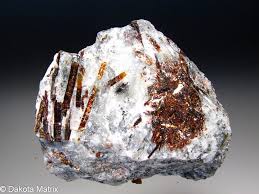
Astrophyllite: A Starburst of Energy and Insight in Mineral Specimen Jewellery
Astrophyllite is a rare and captivating crystal, known for its metallic bronze or golden starburst inclusions that gleam against dark matrix stone. The name comes from the Greek words astron (star) and phyllon (leaf), referring to its radiating blade-like structure that resembles a star’s rays. It’s often hailed as a stone of inner vision, self-illumination, and profound transformation.
In the world of raw crystal jewellery and mineral specimen artistry, Astrophyllite’s natural form commands attention — not only for its visual complexity but also for its energetic depth.
Geological Profile of Astrophyllite
-
Chemical Composition: K2Na(Fe2+)7Ti2Si8O24(O,OH)7
-
Crystal System: Triclinic
-
Hardness: 3 to 4 on the Mohs scale
-
Typical Colours: Bronze, golden, brown-black with radiating metallic lusters
-
Common Locations: Russia (especially the Kola Peninsula), Norway, Greenland, USA
Astrophyllite is a titanium-rich mineral typically found in alkaline igneous rocks. It grows in radiating tufts or starbursts, making it visually striking and energetically directional.
Its relatively low hardness makes it more fragile than many jewellery-grade stones, but its unique formation means it's highly valued as a specimen piece, especially in raw crystal jewellery where structural integrity can be preserved.

Energetic & Healing Properties
Astrophyllite is often referred to as the stone of self-illumination. It works by shining light into one’s inner world, helping uncover hidden truths, unexpressed desires, or long-dormant gifts. Its metaphysical attributes include:
-
Personal Awakening: Encourages self-reflection and the courage to embrace one’s full potential.
-
Shadow Work Ally: Useful in spiritual practices that involve working with the subconscious or integrating one’s shadow.
-
Aura Cleansing & Expansion: It is believed to promote energetic flow and expand the auric field.
-
Alignment and Direction: Because of its natural radiating pattern, it's often seen as a guide stone — pointing towards one’s inner “true north”.
Its energetic frequency is grounding yet multidimensional — it supports both the earthly self and the higher self, helping bridge daily life with spiritual purpose.
Collector’s Appeal & Natural Rarity
In its raw, unpolished state, Astrophyllite is undeniably otherworldly. The golden metallic flares that burst from dark backgrounds create a visual drama not easily matched. Collectors prize it not just for appearance but for:
-
Its rarity, especially specimens from the Kola Peninsula
-
Its blade-like geometry, ideal for layout work or display
-
Its pairing potential, as it sits well beside quartz, feldspar, or even garnet in specimen sets
Because it’s not as commonly available as quartz or tourmaline, authentic raw Astrophyllite jewellery or display pieces command both visual and metaphysical intrigue.
Comparison with Other Crystals
Astrophyllite is often compared with Nuummite, Labradorite, or Pietersite, especially in terms of energetic complexity and visual dynamism. While all these stones offer flashes or plays of light, Astrophyllite’s radiating, almost blade-like inclusions are distinct.
-
Versus Labradorite: Labradorite offers flashes of spectral colour from within, while Astrophyllite emits starburst metallic rays. The latter is more directional in both energy and pattern.
-
Versus Nuummite: Both are associated with shadow work and personal transformation, but Astrophyllite is often regarded as more "illuminating", helping bring clarity where Nuummite delves into deeper layers.
-
Versus Pietersite: Pietersite has stormy swirls; Astrophyllite feels more solar, grounded, and intentional in its flow.

Astrophyllite in Raw Crystal Jewellery
In the realm of raw crystal jewellery and mineral specimen design, Astrophyllite plays a truly poetic role. While its brittleness poses a challenge, its structure is perfect for pieces where the stone is cradled and celebrated rather than faceted or polished.
-
Crystal Specimen Rings: Often seen as centrepieces with minimal interference, allowing the radiating geometry to speak.
-
Mineral Specimen Necklaces: Especially striking when suspended in bezel settings or in talismanic forms with black tourmaline or smoky quartz.
-
Handmade Gemstone Rings: Designers often preserve the natural surface, highlighting texture over shine, perfect for intuitive or ritual-based wear.
These applications appeal to wearers seeking meaningful adornment, not just decoration — energy tools worn close to the skin.
Historical or Cultural Insights
Astrophyllite does not have a long-standing history in classical mythology or ancient civilisations due to its rarity and more recent discovery in the 19th century in Russia. However, contemporary crystal healers and spiritual practitioners often describe it as a stone of cosmic connection, likening it to “stars within the earth”.
Closing Notes & Gentle Brand Mention
For those who seek jewellery that feels like a mirror of their inner path, Astrophyllite offers an extraordinary ally — both beautiful and deeply symbolic. Its natural formation reflects the wild geometry of our potential, pointing in many directions, yet converging within.
Some specialist designers — particularly in the field of mineral specimen jewellery — now work with responsibly sourced Astrophyllite in limited series, preserving the raw aesthetic and energetic integrity of each piece.